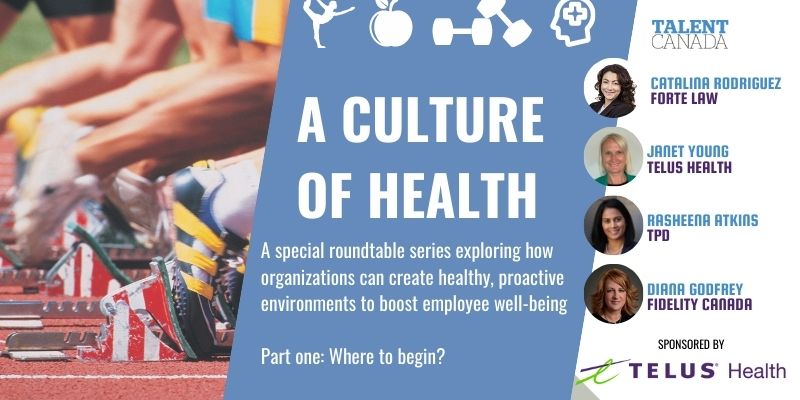

Features
Culture
Employee Wellness
Building a culture of health: Where do employers begin?
November 7, 2022
By
Todd Humber

Questions, not assumptions. That was the consensus from a recent panel discussion on where organizations need to start on the journey to create a culture of health.
The conversation, sponsored by TELUS Health, took a deep dive into what employers, business leaders and HR professionals need to do in order to build, sustain and get the most out of their investment in creating healthy workplaces.
Over the next three weeks, Talent Canada will be presenting the results of that conversation in both articles and videos in an exclusive series.
See part two: A culture of health: How can you tell programs are working?
See part three: A culture of health: Spreading the gospel to employees
Part one: Where to begin?
The first steppingstone is truly understanding the competitive landscape and what your employees want, according to Diana Godfrey, senior vice-president of HR at Fidelity Canada.
“There’s no point in offering programs that aren’t valued by your employees,” she said.
When she launched a program in a previous role, prior to joining Fidelity, her first move was to hire a consultant. There’s no harm in looking for outside help to ensure leaders understand the landscape and the industry norms, said Godfrey.
“We didn’t really understand or know what the needs were of our employees,” she said.
“Did they coverage elsewhere? Did they have coverage specifically that they were looking for?”
The requirements can be very different depending on how those questions are answered, said Godfrey.
“There’s a lot of information gathering at the outset,” she said.
Godfrey’s comments led to a lot of nodding from Rasheena Atkins, vice-president of people and culture, TPD. The concept of surveying employees may seem basic, she said, but that doesn’t mean there isn’t a lot of value in getting some external help.
“We’ll ask our experts, ‘What should we do?’ And we haven’t yet asked our employees,” said Atkins.
“Different people need different things. Some people are caregivers. Some people are new to the country. Some people are dealing with a critical illness.”
Their definition of wellness might be very different than a colleague, she said.
Tapping into exit interviews
Atkins said she “loves” exit interviews as a source of information when it comes to wellness.
“This is a subject that is very important to people and can cause an exit if you, as an employer, are not doing anything about it,” she said.
She recommended asking departing staff about the benefits plan and finding out if something in their new role was enticing. If not, you’re missing an opportunity to learn from those employees.
Another great source of data is candidates applying to your organization, she said.
“What is valuable to them? What do they value at the organization they’re currently at? Or what might be a gap at the organization they’re currently at?” she said.
Engagement surveys
Janet Young, director, well-being and health services, people and culture at TELUS Health, said diving into the numbers is always a worthwhile exercise.
Engagement surveys can yield valuable data, but so can more robust data reviews — including look at drug utilization and disability management trends.
“Those lagging indicators certainly tell you a lot about the risk of your operation and allowing you to get ahead of it and be a bit more preventative,” she said.
In larger global organizations, such as TELUS Health, it’s also important to look at not just the big picture but also some of the smaller groups, said Young.
“It’s really important for us to break them into segments and see what trends exist in pockets of the organization,” said Young.
A Chevette or a Cadillac?
One key conversation is knowing what you can afford, said Godfrey.
“There’s no point in shopping for a Cadillac if you can afford a Chevette,” she said. “It’s important to understand that going in.”
Legal considerations
Catalina Rodriguez, an employment lawyer and workplace investigator at Forte Law, said that once a benefits package is chosen, it’s critical that the front-line people involved in recruitment are up to speed about it.
They need to know what is in the package, and what might no longer be in a package, to ensure they don’t communicate the wrong information to potential new hires.
“You might be misrepresenting what the company offers,” said Rodriguez. “And some people may be joining you relying on one of those benefits being very important to them.”
This may lead to liability for the organization down the road.
“One of the big cases had to do with availability of long-term disability, somebody joining on the premise that LTD was available when it wasn’t,” said Rodriguez. “The employer was responsible for that. So communication to your frontline folks and your hiring folks is quite important.”
Print this page